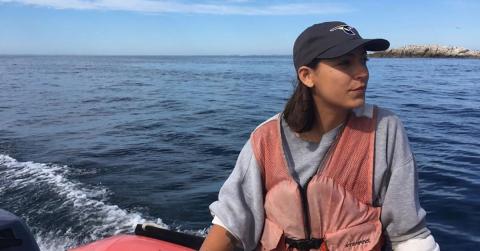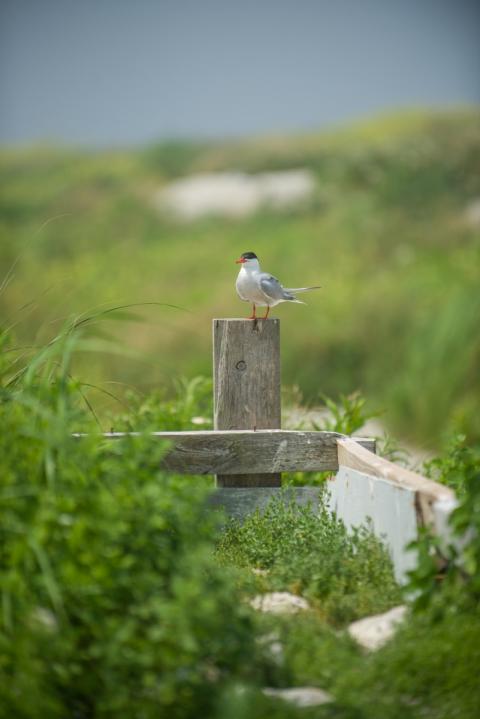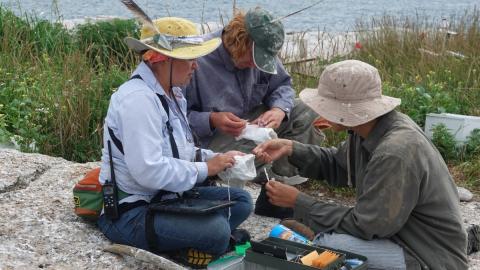Graduate Student Feature: Sampling Plastic Pollution and Fisheries with Seabirds

UNH graduate student Aliya Caldwell has spent a lot of time thinking about the diets and foraging habits of seabirds in the Isles of Shoals. This summer, she was part of a skeleton crew continuing research efforts focused on the islands’ tern populations off the coast of New Hampshire.
“I think I've always been really intrigued and interested in foraging ecology because that is one of the most important factors in seabird survival,” Caldwell said.
Caldwell first came to the Isles of Shoals as an intern at the Shoals Marine Laboratory in 2018, when she was still an undergraduate student at Rutgers University. The rocky islands of the Isles of Shoals offer breeding colony sites for Gulf of Maine seabirds, like gulls and terns. During summer field seasons, students and scientists from the Shoals Marine Laboratory are well-positioned to study the behaviors of seabirds and monitor the health of nesting seabird populations. Alongside research mentors, Dr. Elizabeth Craig and Dr. Jennifer Seavey, Caldwell investigated why different species of gulls might be ingesting more plastic than others.

“We were looking at herring gulls and black-backed gulls, seeing that herring gulls were ingesting far more plastics than black-backed gulls, and starting to think about why that might be,” Caldwell explained. Plastic debris enters the marine environment through various pollution pathways and can be mistaken by seabirds and other marine animals as food.
Caldwell, Craig, and Seavey hypothesized that the foraging strategies each species employs to find food could determine how much plastic each consumes. “If a species is a scavenging species, you would probably expect it to be ingesting a wider range of plastics and more plastics. It might be more likely to mistake a piece of plastic for a food item and it might be more likely to pick up plastics if it has a broader foraging range,” Caldwell said.
Based on this research, Caldwell published a paper as lead author in 2019, co-authored by Craig and Seavey, in Limnology and Oceanography Letters.
Caldwell then applied her work with plastic ingestion in gulls to the neighboring tern colony on the Isles of Shoals – home to common, arctic, and roseate terns. Caldwell and Craig developed a new project to establish a way to isolate and quantify microplastics from terns, hoping to get a baseline understanding of microplastic consumption in the colony studied by Shoals Marine Laboratory's Tern Conservation Program.
Compared to the gulls, which consume plastic directly, terns are more likely to get plastic from their diet by eating fish or other prey items that have already ingested microplastics. (Microplastics are defined as pieces of plastic smaller than five millimeters in diameter.) Caldwell and Craig will be comparing microplastic content across different sites from the Isles of Shoals, New Jersey, and Massachusetts. The extra sites will allow them to compare microplastic consumption in different marine environments, opening the door to studying seabirds as an indicator of plastic pollution on a larger, regional scale. They received NH Sea Grant development funding to process their samples.
This summer, Caldwell has been assisting Craig, Seavey, and co-investigator Dr. Nathan Furey with a NH Sea Grant-funded research project which explores seabirds as a different kind of indicator – one for the health of young fish populations. Traditionally, the abundance of small fish in the Gulf of Maine has been difficult to measure. Knowing how many small fish exist in an area is a good way to predict adult fish populations a few years down the line, which would be important information for managing recovering fisheries.
"Can we predict fisheries catch two or three years in the future, or four years depending on the species, by looking at what the terns have been bringing in?"
- ALIYA CALDWELL, UNH GRADUATE STUDENT
Though the COVID-19 pandemic has delayed this research project's planned sampling trips and some of the fieldwork, Caldwell has been able to draw on data from Isles of Shoals tern monitoring efforts that have been ongoing since 1999, including data on the diets of baby terns in their nests. Tern chicks are fed whatever their parents bring them from foraging at sea. By observing what adult terns bring back to the nest and recording those fish species before hungry beaks descend for a meal, the research team has accumulated years of valuable tern diet data.
In parallel, fellow University of New Hampshire graduate student Nate Hermann has been compiling federal fisheries sampling data to compare to the fish species present during annual fisheries surveys with the tern diet data from the Isles of Shoals. The combination of these two datasets aims to improve our understanding of Gulf of Maine fisheries. “Terns are foraging on smaller forage fish, which are juvenile fishes zero to two years in age. Those specific fish are not in the fisheries data; the fisheries data are the adult fish,” Caldwell explained. “Can we predict fisheries catch two or three years in the future, or four years depending on the species, by looking at what the terns have been bringing in?”
Looking ahead, the research team will conduct boat-based sampling trips at sites where terns are known to forage for fish so that they can judge how effective the terns are as a fisheries sampling crew.
Caldwell sees connecting her work with seabirds to fisheries as filling in the other side of the equation she’s been working on for years. “I'm really excited to finally be able to dig deep into the other side of it, which is the fish,” Caldwell said. "I feel like that's something that has been missing. There are bird people and there are fish people, and everybody understands that this interaction is really important, especially for management, but there's been a bit of a disconnect.”
Caldwell is starting a full-time Master’s program this fall at the University of New Hampshire as part of Dr. Nathan Furey's lab. For now, she’s enjoying learning about a new system from a new point of view. “Anytime I have the opportunity to try to get a more well-rounded understanding and end-view of a system, that’s super exciting,” she says.

Aliya Caldwell (right), Dr. Elizabeth Craig (left), and seabird technician Beckley Stearns (middle) conduct fieldwork in the tern colony on White Island, Isles of Shoals. The researchers wear hats to shield their heads from protective adult terns who dive down to peck intruders near nest sites.
Photos courtesy of Aliya Caldwell.